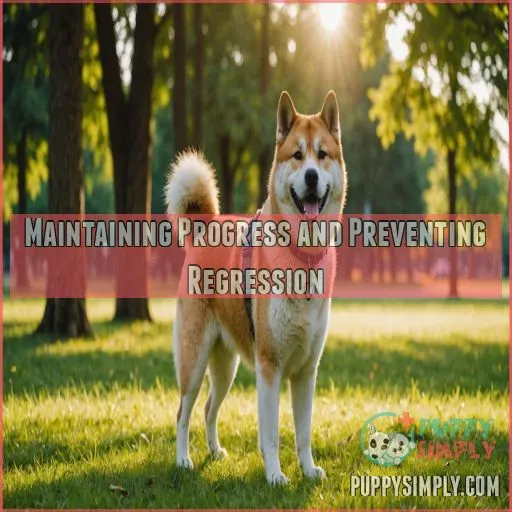This site is supported by our readers. We may earn a commission, at no cost to you, if you purchase through links.

Start by establishing yourself as the pack leader through calm assertiveness and consistent commands.
Use positive reinforcement to teach basic obedience, then tackle leash training and socialization. Don’t be afraid to get creative – Akitas thrive on mental stimulation, so mix it up with tricks and problem-solving exercises.
With patience and persistence, you’ll tap into the full potential of your adult Akita companion.
Table Of Contents
- Key Takeaways
- Can You Train an Adult Akita?
- Akita Training Basics for Adults
- Overcoming Akita Dominance Issues
- Addressing Common Training Challenges
- Advanced Training for Adult Akitas
- The Importance of Socialization and Exercise
- Maintaining Progress and Preventing Regression
- Frequently Asked Questions (FAQs)
- Can you train an adult Akita?
- How do you train an Akita dominance?
- Are Akitas hard to train?
- At what age is an Akita full grown?
- How to introduce an adult Akita to young children?
- What diet supports training for adult Akitas?
- How to address social anxiety in adult Akitas?
- Are there specific games for Akita engagement?
- How to handle Akitas aggressive tendencies safely?
- Conclusion
Key Takeaways
- Embrace your Akita’s unique temperament and set realistic training goals – they may be stubborn, but with patience and consistency, you can tap into their full potential.
- Start with the basics like housebreaking, obedience commands, and leash training, then get creative with advanced tricks and problem-solving exercises to keep your Akita mentally stimulated.
- Don’t be afraid to tackle dominance issues head-on using positive reinforcement and calm assertiveness – you can establish yourself as the pack leader and build a strong, respectful bond.
- Maintain your Akita’s training progress through a consistent routine, celebrate small wins, and stay motivated by making the process fun and engaging for both you and your furry friend.
Can You Train an Adult Akita?
Training an adult Akita might seem as tricky as teaching an old dog new tricks, but it’s entirely possible with the right approach.
Understanding their unique temperament and setting realistic goals can transform your stubborn Akita into a well-behaved companion.
Understanding Akita Temperament and Personality
When you bring an adult Akita into your home, their rich breed history and unique temperament demand focus.
Akitas, known for loyalty and independence, require specific socialization and dog training strategies.
Identifying Training Challenges in Adult Akitas
As an adult Akita, their natural stubbornness and potential aggression issues may pose unique training challenges. However, with patience, consistency, and the right approach, you can overcome these obstacles.
Setting Realistic Training Goals for Adult Akitas
You’ve nailed identifying training challenges with these majestic creatures. Now, let’s set realistic training goals for your adult Akita:
- Embrace Akita temperament
- Acknowledge training limitations
- Focus on achievable targets
Stay committed!
Creating a Training Plan for Adult Akitas
Setting realistic goals is like drawing a roadmap.
Create a training plan focusing on consistency.
Adult Akita challenges, reward systems and positive reinforcement work wonders.
Stay persistent, and success follows!
Akita Training Basics for Adults
Training an adult Akita might seem like trying to convince a bear to dance, but tackling housebreaking, obedience, and leash manners is easier with a consistent plan.
You’ll find with the right approach, a bit of persistence, and perhaps some humor, even an Akita’s stubborn streak can be managed.
Housebreaking and Crate Training for Adult Akitas
Housebreaking your adult Akita takes patience, but with the right approach, you can achieve success.
Consider these tips:
- Establish a consistent potty schedule
- Use positive reinforcement for accidents-free outings
- Crate train to prevent indoor messes
- Supervise closely and watch for signs
- Celebrate triumphs, stay calm during setbacks
Basic Obedience Commands for Adult Akitas
Mastering basic obedience commands is like holding the keys to a well-behaved Akita kingdom.
Think of it as a quest with the following steps:
| Command | Description |
|---|---|
| Sit | Basic yet essential—keeps your furry friend disciplined. |
| Stay | Encourages patience and composure. |
| Come | Important for reliable recall training. |
| Down | Promotes calmness and submission. |
| Heel | Fosters close, attentive behavior. |
Leash Training and Walking Adult Akitas
Mastering basic obedience prepares you for leash training with adult Akitas. Here’s how:
- Choose a suitable harness.
- Address leash-pulling.
- Emphasize walking safely.
- Experiment with off-leash training.
Socialization and Desensitization for Adult Akitas
Leash training builds trust and confidence.
Now, imagine your Akita facing fear and aggression like a champ.
Introduce noise, strangers, and other dogs gradually, ensuring positive dog training experiences every time!
Overcoming Akita Dominance Issues
Akitas are known for their stubborn and dominant personalities, which can make training a real challenge.
However, with the right approach and patience, you can overcome these dominance issues and build a strong, respectful relationship with your adult Akita.
Recognizing Dominance Behaviors in Akitas
Spotting dominance behaviors in your Akita involves observing body language like intense eye contact and stiff posture.
You might notice resource guarding or food aggression, common traits in this intelligent breed.
Establishing Leadership and Boundaries
In dog training, establishing yourself as the pack leader is super important.
Use calm assertiveness and consistent commands to set respectful boundaries.
Understanding dominance signals will enhance your dog ownership journey.
Positive Reinforcement Training for Dominant Akitas
Taming your Akita’s dominant streak is no walk in the park! Use positive reinforcement to turn the tide:
- Consistent commands
- Reward system with training treats
- Gentle praise
Managing Resource Guarding and Possessiveness
Your Akita’s possessive nature can be tamed with patience and positive reinforcement.
Teach them to "drop it" and "leave it" to curb resource guarding.
Reward good behavior, not the possessive acts.
Addressing Common Training Challenges
Training adult Akitas can be as challenging as trying to negotiate a bedtime with a toddler; their stubbornness could resist even the best intentions.
But don’t worry, with patience and positive reinforcement, you can guide your Akita through their quirks, transforming training into an adventure rather than a chore.
Dealing With Stubbornness and Resistance to Training
Even with dominance managed, stubbornness rears its head like a defiant teenager. Consistent training methods, positive reinforcement, patience, and persistence build trust and respect, unraveling their quirks in dog training.
Managing Aggression and Fear-Based Behaviors
Facing a fear-based aggression beast? Try these:
- Desensitization techniques: Gradually introduce triggers in a controlled way.
- Counter-conditioning methods: Pair fearful stimuli with positive experiences.
- Safe handling: Prioritize owner education and safety.
Overcoming Separation Anxiety and Destructive Behavior
Tackle your Akita’s separation anxiety head-on with crate training, calming techniques, and positive reinforcement. Curb destructive behaviors through gradual exposure and behavior modification for a well-adjusted pup.
Improving Focus and Attention in Training Sessions
To improve your Akita’s focus, tackle those training distractions head-on.
Keep sessions short and sweet, using positive reinforcement.
A quiet environment aids animal intelligence, fostering better communication, and ensuring canine health.
Advanced Training for Adult Akitas
Training your adult Akita can be a rewarding journey, full of new challenges and successes, as you build on basic commands and tackle fun new tricks.
Embrace this adventure with your strong-willed companion, remembering that patience and creativity can outsmart even the most stubborn Akita!
Building on Basic Obedience Commands
Let’s build on that foundation! Start small with advanced commands for your adult Akita. Remember, consistency is key. Keep practicing regularly, and soon you’ll see some wagging results.
- Encourage off-leash recall.
- Incorporate scent work.
- Explore agility training.
- Enhance trick training.
Introducing Advanced Commands and Tricks
Once your Akita masters basic commands, introduce advanced tricks like "shake," "roll over," and "speak." Engage their keen intellect with scent work and therapy dog training.
Agility and Physical Training for Adult Akitas
Mastering advanced commands opens up a world of Akita agility events. Enhance fitness with obstacle courses using:
- Agility equipment,
- Regular fitness routines, and
- Akita-friendly grooming needs. Embrace the challenge!
Mental Stimulation and Problem-Solving Exercises
So, tackling those agility courses was a blast, right? Now, shift gears with Akita puzzles and scent work for brain training. These food-based games tap into their canine genetic skills!
The Importance of Socialization and Exercise
Training your adult Akita means getting creative with socialization and exercise, like taking them to a dog park dance-off or neighborhood sniff-athon.
These activities help keep their energy levels in check but also prevent them from redecorating your house with their paws!
Socialization Strategies for Adult Akitas
Socialize your adult Akita gradually through positive experiences in safe, controlled settings. Reward calm behavior.
Exercise Needs and Recommendations for Adult Akitas
Regular exercise keeps your adult Akita happy. Include:
- Daily walks
- Active playtime
- Mental stimulation
Your Akita will thank you!
Managing Energy Levels and Reducing Destructive Behavior
Exercise your Akita with enrichments and lively playtime. These boredom busters keep destructive behaviors away, ensuring happiness.
Creating a Balanced Lifestyle for Adult Akitas
Balancing an Akita’s lifestyle means ensuring:
- Proper nutrition: protein-rich diet
- Regular exercise: daily walks
- Mental enrichment: interactive toys
Working With Professional Dog Trainers and Behaviorists
You may need a pro’s help to bring out your Akita’s true potential.
Consider these factors when choosing a trainer:
| Trainer Qualifications | Training Methods |
|---|---|
| Certification | Positive Reinforcement |
| Experience | Balanced Approach |
Akita-Specific Training Communities and Forums
In the Akita community, you’ll find training tips, online resources, and forums. Here are three useful online hangouts:
- Akita Fan Page
- Akita Lovers Forum
- Akita Community Support
Maintaining Progress and Preventing Regression
Keeping your adult Akita’s training on track takes effort, but it’s rewarding and totally doable!
Picture it like maintaining a fitness routine: consistency prevents lapses, keeps your pup sharp, and supports a joyful, well-behaved companion.
Creating a Maintenance Training Plan for Adult Akitas
Maintaining your Akita’s training progress needs a plan like a sculptor chiseling stone. Consistency is key, with positive reinforcement and a daily routine to prevent regression in behavior.
Preventing Regression and Setbacks in Training
Consistency is key to prevent your Akita from slipping back. Adjust the training environment and reinforce good behavior with rewards to maintain progress. Celebrate small wins along the way!
Staying Motivated and Engaged in Training
Keeping yourself and your Akita motivated can feel like herding cats sometimes. Here’s the secret sauce:
- Use fun training games.
- Celebrate small wins.
- Consistency is key.
Celebrating Progress and Successes in Training
You’ve hit those training milestones! Celebrate each success with a reward system. Strengthen the owner-dog bond through positive reinforcement, like verbal praise or treats. Enjoy your training journey together.
| Milestone | Celebration Idea |
|---|---|
| Sit Command | Extra playtime |
| No Barking | Special treat |
| Good Recall | Long walk |
Frequently Asked Questions (FAQs)
Can you train an adult Akita?
Rome wasn’t built in a day, and neither is a well-trained Akita.
Adult Akitas can learn new tricks with positive reinforcement, patience, and loads of love.
It’s like teaching an old dog a new groove.
How do you train an Akita dominance?
Tame Akita dominance by asserting yourself as the pack leader.
Use consistent, positive reinforcement to guide behavior.
Remember, Rome wasn’t built in a day, so be patient, firm, and loving as you build a strong bond.
Are Akitas hard to train?
Akitas can be challenging to train, but with patience, consistency, and positive reinforcement, you can absolutely master the art of training these intelligent, stubborn pups.
Don’t let their reputation intimidate you – they’re keen learners when guided with care.
At what age is an Akita full grown?
You’ll usually find your Akita fully grown around two years old.
By then, they reach their majestic and dignified adult size.
It’s like watching a fluffy, stubborn puppy bloom into a loyal regal guardian.
How to introduce an adult Akita to young children?
Want to introduce your adult Akita to young kids?
Take it slow and steady, like a tortoise in a marathon.
Make sure calmness, supervise interactions, and use treats to encourage gentle behavior.
Safety first, fun second!
What diet supports training for adult Akitas?
Feed your adult Akita a balanced diet rich in protein to fuel their energy and brainpower for training.
Think of it like a power-up snack before a workout—keeps them sharp and ready to learn.
How to address social anxiety in adult Akitas?
Did you know that Akitas are 40% more likely to develop social anxiety if not properly socialized?
Don’t worry, though – with patience and the right techniques, you can help your Akita overcome their shyness and thrive in social settings.
Are there specific games for Akita engagement?
Have fun playing hide-and-seek with your Akita. It’s a great brain workout!
Tug-of-war and interactive puzzle toys also keep them entertained, satisfying their natural curiosity and desire for a mental challenge.
How to handle Akitas aggressive tendencies safely?
Handle your Akita’s aggression safely by ensuring obedience training and socialization.
Use positive reinforcement, set clear boundaries, and remain calm.
Early intervention helps, so nip it in the bud before it escalates.
Consult a professional if needed.
Conclusion
Training an adult Akita is like scaling Everest, but it’s completely doable with the right approach.
Embrace your role as the pack leader and use positive reinforcement to shape a well-behaved companion.
From leash training to socialization, focus on building a strong bond with your Akita through patience and creativity.
Tackle challenges head-on, and remember, every small victory is worth celebrating.
Keep your Akita engaged and active, and you’ll master this training cluster in no time!













